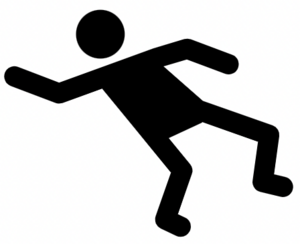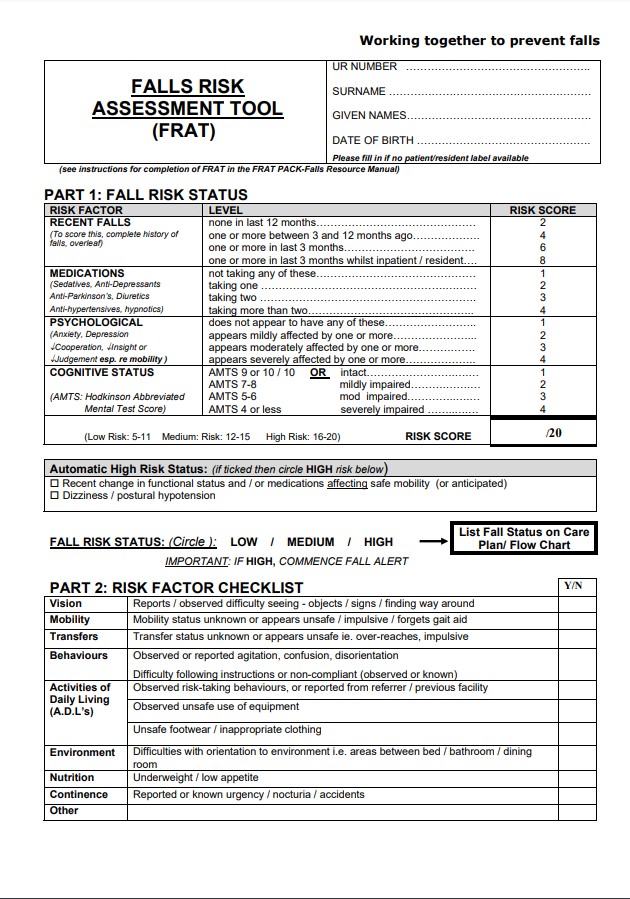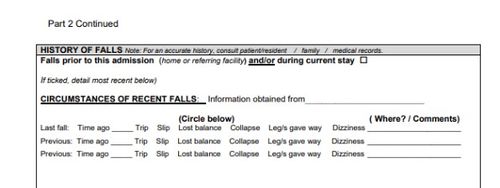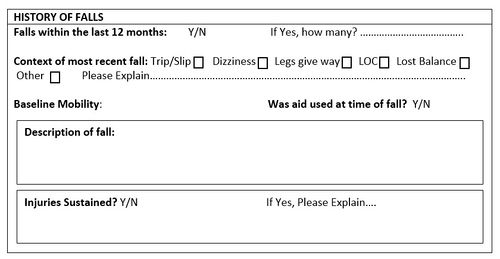Falls Risk Assessment Tool (FRAT): Difference between revisions
No edit summary |
(added FRAT development, need, use, risk classification) |
||
| (5 intermediate revisions by 2 users not shown) | |||
| Line 2: | Line 2: | ||
'''Original Editor '''- [[User:Shaun Jackson|Shaun Jackson]] as part of the [[Northumbria University Innovation and Contemporary Physiotherapy Project|Northumbria University Innovation and Contemporary Physiotherapy Project]] | '''Original Editor '''- [[User:Shaun Jackson|Shaun Jackson]] as part of the [[Northumbria University Innovation and Contemporary Physiotherapy Project|Northumbria University Innovation and Contemporary Physiotherapy Project]] | ||
'''Top Contributors''' - {{Special:Contributors/{{FULLPAGENAME}}}} | '''Top Contributors''' - {{Special:Contributors/{{FULLPAGENAME}}}} [[User:Momina Khalid|Momina Khalid]] | ||
</div> | </div> | ||
== Introduction == | == Introduction == | ||
[[Falls in elderly|Falls]] are | [[File:Falling.png|right|frameless]] | ||
[[Falls in elderly|Falls]] are common within the elderly population. Adverse effects of falsl include fracture, fear of falling, and death. Falls are the second-leading cause of accidental injury deaths worldwide. Each year, an estimated 684 000 individuals die from falls worldwide. Adults older than 60 years of age experience the greatest number of fatal falls.<ref>WHO Falls Available:https://www.who.int/news-room/fact-sheets/detail/falls (accessed 2.11.2022)</ref> | |||
A range of tools are available to health care providers to identify those at risk of falling. Tools include: Falls Risk Assessment Tool (FRAT); [[Berg Balance Scale]]; [[Timed Up and Go Test (TUG)]]; [[The Balance Outcome Measure for Elder Rehabilitation (BOOMER)|The Balance Outcome Measure for Elder Rehabilitation (BOOMER).]] | Falls are taken into account as an assessment of the quality of care, and fall prevention is a component of quality control systems. A patient's risk of falling is objectively assessed by a fall risk assessment. A range of tools are available to health care providers to identify those at risk of falling. A number of tools have been designed for assessing fall risk. Tools include: the Falls Risk Assessment Tool (FRAT); the [[Berg Balance Scale]]; [[Timed Up and Go Test (TUG)]]; [[The Balance Outcome Measure for Elder Rehabilitation (BOOMER)|The Balance Outcome Measure for Elder Rehabilitation (BOOMER).]] | ||
== Development Of FRAT Tool == | |||
In 1999, the Peninsula Health Prevention Service developed the Falls Risk Assessment Tool (FRAT). Previous assessments of research indicated fall risk variables among older community members. It was a two-year research project.<ref>Falls Risk Assessment Tool (FRAT) [Internet]. Available from: <nowiki>https://content.health.vic.gov.au/sites/default/files/migrated/files/collections/policies-and-guidelines/b/b2b_1a_frat_pdf.pdf</nowiki> | |||
</ref>FRAT is filled by the nursing staff in hospital and healthcare facility. | |||
== Need of FRAT == | |||
FRAT tool helps us achieve the following outcomes: | |||
* It is useful in providing a focal point for all the fall -elated information. | |||
* Helps in predicting the fall risks of individuals with accuracy. | |||
* Help in identyfying people who are most likely at high risk and direct resources towards them. | |||
* Targeting preventive measures who those identified as at high risk of falling. | |||
== Fall Risk Assessment Tool Use == | |||
FRAT is used as: | |||
=== A screening Tool === | |||
By calculating a risk score, the person carrying out the assessment can identify who is at high risk of fall | |||
=== An assessment Tool === | |||
This tool can also identify the possible risk factors contributing to falling and help in formulating an individual plan of care. | |||
=== '''FRAT''' === | === '''FRAT''' === | ||
It is a '''4-item falls-risk screening tool''' for sub-acute and residential care. The FRAT has three sections: | It is a '''4-item falls-risk screening tool''' for sub-acute and residential care. The FRAT has three sections: | ||
* Part 1 - | * Part 1 - Fall Risks. | ||
* Part 2 | * Part 2 –Rrisk factor checklist. | ||
* Part 3 | * Part 3 :Action Plan<ref>Stapleton C, Hough P, Oldmeadow L, Bull K, Hill K, Greenwood K. Four‐item fall risk screening tool for subacute and residential aged care: The first step in fall prevention. Australasian Journal on Ageing. 2009 Sep;28(3):139-43.</ref>. | ||
[[File:FRAT.jpg]] | [[File:FRAT.jpg]] | ||
A full copy of the FRAT tool can be accessed via the following link: [https://www2.health.vic.gov.au/Api/downloadmedia/%7BC542FA9B-1A24-4C5C-B921-C8A8ADDC1A9C%7D] | A full copy of the FRAT tool can be accessed via the following link: [https://www2.health.vic.gov.au/Api/downloadmedia/%7BC542FA9B-1A24-4C5C-B921-C8A8ADDC1A9C%7D] | ||
== | == PART 1 : FALL RISK STATUS == | ||
Part one will categorize the individual into three categories, low, medium or high. the score is obtained by marking one score in each o the four categories of part 1. | |||
the risk classification status is as: | |||
{| class="wikitable" | |||
|+'''RISK CLASSIFICATION LEVEL''' <ref name=":1">.The Falls Risk Assessment Tool (FRAT) 121 ASSESSMENT TOOLS What is the Falls Risk Assessment Tool [Internet]. Available from: <nowiki>https://training.aacs.com.au/wp-content/uploads/2016/08/Falls-Risk-Assessment-Tool-FRAT.pdf</nowiki> | |||
</ref> | |||
! | |||
!'''Score''' | |||
!'''Risk Classification''' | |||
|- | |||
!'''Low risk''' | |||
!5-11 | |||
!Provide standard care and follow general patient safety principles | |||
|- | |||
|'''Medium risk''' | |||
|12-15 | |||
|Provide Standard Care but risk factors have been identified and strategies integrated in the care plan to target area of risk | |||
|- | |||
|'''High risk''' | |||
|16-20 | |||
|Commence Fall Alert Protocol. Patient has a high likelihood of a fall occurring | |||
|} | |||
== | == FALL ALERT PROTOCOL == | ||
Individuals having high risk on the FRAT score corresponds to FALL Alert Protocol. | |||
* Orange alert stickers paced on bed, plan o care and front page . | |||
* Fall alert is documented on handover sheet as long as the patient remains on Fall Alert Protocol | |||
* Individuals withy high risk are recommended to wear orange am band . <ref name=":1" /> | |||
== Criticism of FRAT == | == Criticism of FRAT == | ||
Latest revision as of 06:45, 10 January 2024
Original Editor - Shaun Jackson as part of the Northumbria University Innovation and Contemporary Physiotherapy Project
Top Contributors - Kim Jackson, Shaimaa Eldib, Lucinda hampton, Vidya Acharya, Shaun Jackson and Momina Khalid Momina Khalid
Introduction[edit | edit source]
Falls are common within the elderly population. Adverse effects of falsl include fracture, fear of falling, and death. Falls are the second-leading cause of accidental injury deaths worldwide. Each year, an estimated 684 000 individuals die from falls worldwide. Adults older than 60 years of age experience the greatest number of fatal falls.[1]
Falls are taken into account as an assessment of the quality of care, and fall prevention is a component of quality control systems. A patient's risk of falling is objectively assessed by a fall risk assessment. A range of tools are available to health care providers to identify those at risk of falling. A number of tools have been designed for assessing fall risk. Tools include: the Falls Risk Assessment Tool (FRAT); the Berg Balance Scale; Timed Up and Go Test (TUG); The Balance Outcome Measure for Elder Rehabilitation (BOOMER).
Development Of FRAT Tool[edit | edit source]
In 1999, the Peninsula Health Prevention Service developed the Falls Risk Assessment Tool (FRAT). Previous assessments of research indicated fall risk variables among older community members. It was a two-year research project.[2]FRAT is filled by the nursing staff in hospital and healthcare facility.
Need of FRAT[edit | edit source]
FRAT tool helps us achieve the following outcomes:
- It is useful in providing a focal point for all the fall -elated information.
- Helps in predicting the fall risks of individuals with accuracy.
- Help in identyfying people who are most likely at high risk and direct resources towards them.
- Targeting preventive measures who those identified as at high risk of falling.
Fall Risk Assessment Tool Use[edit | edit source]
FRAT is used as:
A screening Tool[edit | edit source]
By calculating a risk score, the person carrying out the assessment can identify who is at high risk of fall
An assessment Tool[edit | edit source]
This tool can also identify the possible risk factors contributing to falling and help in formulating an individual plan of care.
FRAT[edit | edit source]
It is a 4-item falls-risk screening tool for sub-acute and residential care. The FRAT has three sections:
- Part 1 - Fall Risks.
- Part 2 –Rrisk factor checklist.
- Part 3 :Action Plan[3].
A full copy of the FRAT tool can be accessed via the following link: [1]
PART 1 : FALL RISK STATUS[edit | edit source]
Part one will categorize the individual into three categories, low, medium or high. the score is obtained by marking one score in each o the four categories of part 1.
the risk classification status is as:
| Score | Risk Classification | |
|---|---|---|
| Low risk | 5-11 | Provide standard care and follow general patient safety principles |
| Medium risk | 12-15 | Provide Standard Care but risk factors have been identified and strategies integrated in the care plan to target area of risk |
| High risk | 16-20 | Commence Fall Alert Protocol. Patient has a high likelihood of a fall occurring |
FALL ALERT PROTOCOL[edit | edit source]
Individuals having high risk on the FRAT score corresponds to FALL Alert Protocol.
- Orange alert stickers paced on bed, plan o care and front page .
- Fall alert is documented on handover sheet as long as the patient remains on Fall Alert Protocol
- Individuals withy high risk are recommended to wear orange am band . [4]
Criticism of FRAT[edit | edit source]
Include:
- Risk Factor Checklist (Part 2) fails to appreciate balance specifically. If this was a self-reported concern of the patient, areas of proprioception and the vestibular system could be objectively looked at in more depth within specialist physiotherapy. assessment.
- Lacks context – eludes to being objective however fails to provide any guidance on questioning to obtain further information. Area for development – extended box to record subjective and objective measures.
- NICE guidelines state the FRAT does not assess all the risk variables highlighted in their guidelines for falls prevention. Furthermore, NICE state it should not be relied solely on to assess risk of falls and requires further investigation[5]. If high falls risk is identified, more extensive assessment is required – e.g. Elderly Mobility Scale to provide objective measures that guide physiotherapy treatment.
- Nowhere to record a collateral history. Having an area to collect information would allow for exploration into issues and areas highlighted in Part 2.
- ‘History of Falls’ section lacks ability to record detailed mechanics of fall. Tick boxes can be supported by a descriptive component. (See ‘Potential Modifications to the FRAT’).
- Cognitive test included is rather outdated and cannot be relied on to confirm cognitive impairment.
- Recommendation: carry out with several members of MDT present to incorporate areas of expertise.
Potential Modifications to the FRAT[edit | edit source]
During the process of evaluating the FRAT, there is a perceived lack of depth pertaining to the falls section. It is proposed that some amendments could be made to this in order to improve clarity and increase information and reliability.
Current ‘History of Falls’ Section:
Potential Developments:
References[edit | edit source]
- ↑ WHO Falls Available:https://www.who.int/news-room/fact-sheets/detail/falls (accessed 2.11.2022)
- ↑ Falls Risk Assessment Tool (FRAT) [Internet]. Available from: https://content.health.vic.gov.au/sites/default/files/migrated/files/collections/policies-and-guidelines/b/b2b_1a_frat_pdf.pdf
- ↑ Stapleton C, Hough P, Oldmeadow L, Bull K, Hill K, Greenwood K. Four‐item fall risk screening tool for subacute and residential aged care: The first step in fall prevention. Australasian Journal on Ageing. 2009 Sep;28(3):139-43.
- ↑ 4.0 4.1 .The Falls Risk Assessment Tool (FRAT) 121 ASSESSMENT TOOLS What is the Falls Risk Assessment Tool [Internet]. Available from: https://training.aacs.com.au/wp-content/uploads/2016/08/Falls-Risk-Assessment-Tool-FRAT.pdf
- ↑ Centre for Clinical Practice at NICE (UK. Falls: Assessment and prevention of falls in older people. 2013.https://www.nice.org.uk/guidance/cg161










